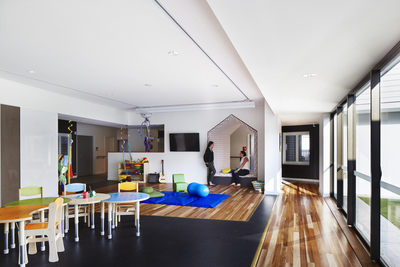Delivering human connection through meaningful architectural design

The underinvestment in palliative care in Australia is a sad reality that is again in the spotlight but should not be ignored.
A report commissioned by Palliative Care Australia calls for an overhaul of the palliative care system in Australia and an additional annual investment of $365 million to bring the system up to speed in a post COVID-19 world.
The National Palliative Care Strategy 2018 identifies that palliative care is not equally available to all Australians. In 2012 the federal government’s study into palliative care found that 3700 children in Queensland were living with life-limiting conditions.
At that time there were only two children’s hospices in Australia: one in Victoria and another in New South Wales. This led to the development of Hummingbird House Queensland.
The state-of-the-art children’s hospice by ThomsonAdsett, finished in 2016, is the only one of its kind in Queensland and took the total of children’s-only hospice facilities in Australia to three.

Hummingbird House gave us important insights into how architectural design can contribute to end-of-life care for all people — particularly for children and teenagers and the impact on their families. It highlighted the tight bonds that exist between design, aesthetics and emotions.
The design solution for Hummingbird House was a direct result of an empathic and human-centred design process involving an extensive briefing and engagement process that included workshopping and research.
A home away from home
The design had to incorporate basic requirements in terms of facilities, but it also had to be a fitting building for what is a wonderful environment. As a team we talked a lot about the link between the building and the nature that surrounds it.
Simply put, Hummingbird House was intended to be more than just a standalone hospice facility with paediatric palliative care services. It had to be a place where families could come to find peace, support and rest in their time of need. The home that helped loved ones discover moments and create memories that would last a lifetime.
And just as a house works as one with its many rooms, the centre offers flexibility to cater for the needs of its many occupants: from the guests and families themselves to its dedicated volunteers and professional staff.
By creating flexible environments where guests and relatives can control furnishings, light and climate, the users have personal control over the environment and can create a temporary home.
Creating a stable environment for the relatives and guests helps facilitate a healing atmosphere.
Colour, form, shape and scale are also important considerations and a child’s scale is quite different from that of an adult, so a flexible design approach is needed.
Buildings should meet not only the physical needs of the guests and the families, but also their cultural and spiritual needs.
At Hummingbird House there is a room dedicated to children after they have died. This temperature-controlled space provides families with the precious gift of time, as their child can remain there for a number of days.
There has been great demand for this room, named the Hummingbird Suite, and including more than one in any future hospice project would be a must.
Focus must lie on creating a healthcare facility that offers professional palliative care, while facilitating a place for guests and relatives to spend their last time together in a dignifying and comfortable manner.
Hummingbird House has a range of accommodation options including eight ‘guests in care’ bedrooms and three two-bedroom adaptable apartments.

Among the design features are an outdoor cinema space, a pool and landscaped gardens. The design also features a rooftop space, which can support workshops and events.
We have learnt that making spaces flexible helps create magical experiences. For example, at Hummingbird House staff held a beach party on the roof terrace for a child who was not expected to make their first birthday.
The team trucked in sand and set up an inflatable pool allowing the child to have the party of a lifetime, before the child’s death a few months later.
Architects must dream big. Think about how to incorporate flexible design so opportunities that would normally occur outside a facility can be held in-house. It makes for a special experience for the guests and families.
By providing thoughtful and flexible spaces for families caring for a child with a life-limiting condition, Hummingbird House delivers human connection through design.
Personally, to be one of the architects involved in the Hummingbird House project was an amazing opportunity, and one which will stay with me throughout my career.
While it has been four years since Hummingbird House was completed, its engaging design and build process is still helping raise awareness and generate public discussion about palliative care, including the specific needs of children with life-limiting conditions as well as the families that love and care for them.
UNSW Health Translation Hub opens
The $600 million UNSW Health Translation Hub — an integrated medical, research and health...
Vertical healing: redefining health care through high-rise hospital design
The high-rise hospital signifies more than a shift in form — it reflects a transformation...
Transforming the treatment experience: Rānui Apartments, New Zealand
The Bone Marrow Cancer Trust's Rānui Apartments offer housing for patients and their families...


![[New Zealand] Transform from Security Awareness to a Security Culture: A Vital Shift for SMB Healthcare — Webinar](https://d1v1e13ebw3o15.cloudfront.net/data/89856/wfmedia_thumb/..jpg)
![[Australia] Transform from Security Awareness to a Security Culture: A Vital Shift for SMB Healthcare — Webinar](https://d1v1e13ebw3o15.cloudfront.net/data/89855/wfmedia_thumb/..jpg)




